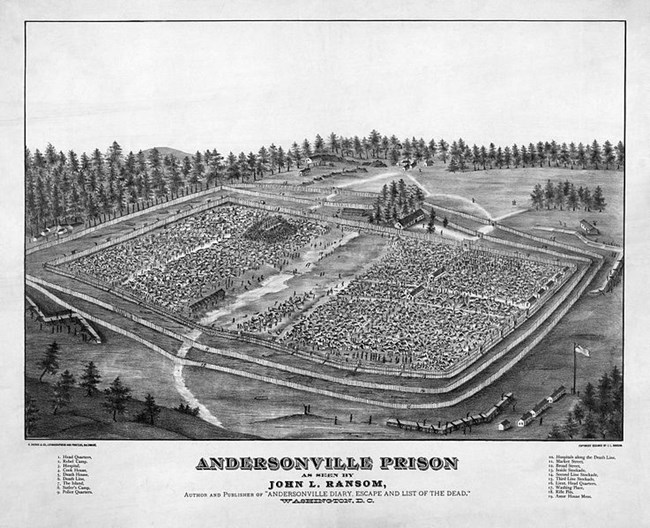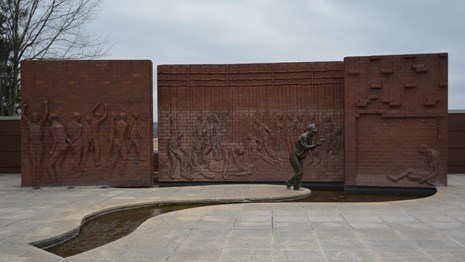Part of a series of articles titled Creative Teaching with Historic Places: Selections from CRM Vol 23 no 8 (2000).
Article • Creative Teaching with Historic Places: Selections from CRM Vol 23 no 8 (2000)
Arizona Students Learn from a Georgia Civil War Prison

https://en.wikipedia.org/wiki/File:Andersonville_Prison.jpg
Published by the National Park Service, Cultural Resources
Arizona Students Learn from a Georgia Civil War Prison
By Patricia Stanley
When teaching my seventh-grade students about the Civil War, nothing leaves more of an impression than the story of Andersonville Prison, a Confederate prison in Andersonville, Georgia, which is now preserved as a national historic site. The Teaching with Historic Places (TwHP) lesson plan, “Andersonville: Prison of War Camp,” is an excellent tool for bringing this story to life in my classroom. Even though they may not have the opportunity to visit the actual national park in Georgia, my Arizona students can learn exciting and relevant information about it by examining the maps, readings, and historic photographs in the lesson plan.
The clearly stated objectives gave me a quick overview of this lesson and enabled me to discern if it met our district assessments. While the readings and other materials in the lesson were outstanding, the activities presented in the Putting It All Together section were an excellent way of delving further into the lesson’s topic as well as meeting several of these assessments.
In the first activity, Empathetic Response, students imagine they are a prisoner in Andersonville as they describe what life was like through diary entries or a letter to a loved one. I was able to tie the book The Boys War by Jim Murphy to the activity. When students learned that Civil War soldiers, including some at Andersonville, were sometimes as young as 12 years old, they were able to relate more to the soldiers’ experiences. In keeping with this, I modified the activity by having students keep a Civil War journal as if they were a 12-year-old soldier. To complete the activity, they created a timeline of their imaginary military career up to and including the time they became a prisoner at Andersonville.
Activity 2, Family History, askes students to research the life of an ancestor who fought in or lived during the Civil War. I was able to incorporate another district assessment – technology – into the activity by having them conduct genealogy searches as part of a Family Tree Internet project. It was a lot of fun for the students to try different search engines to find family descendants. What proved most interesting was that the students took the information home to their families, who became involved in the searches.

Activity 4, The Raiders’ Trial, had students reenact the trial of a band of prisoners known as the Raiders who terrorized other prisoners, or act out the trial of Captain Wirz, the commandant of the prison who was ultimately hanged for war crimes. This activity was appropriate because conducting a mock trial is one of our district assessments. The class did research on Captain Wirz and gathered lots of good information about him and the way he ran the prison.
Activity 5, Prisoner of War Camps, and Activity 6, Interviewing a Former Prisoner of War, fit in with our Kids Voting lessons. Why would Kids Voting have anything to with war camps and POWs? Part of Arizona’s Kids Voting program covers past and current political candidates. John McCain, former Republican presidential candidate and Vietnam POW, is from Arizona. The class did in-depth research about John McCain and his experiences during the Vietnam War. We studied the war and the atrocities the soldiers went through. We combined this activity with a visit to the traveling Vietnam War Wall. Students’ journal writing was fantastic; they compared and contrasted the two wars.
I revised the lesson’s final activity to meet several math standards and a geography standard as well. I developed a question-and-answer sheet based on a map from the lesson showing the locations of Civil War prison camps. Students then tracked distances from camp to camp and researched different elevations and climates. They were even very vocal about which camp they would rather be at because of year-round temperatures and better overall weather conditions. One group would rather brave the snows and the other would rather have the summer humidity.
The students really enjoy this TwHP lesson plan, and it is extremely teacher friendly. It meets several of our district’s standards, and the students walk away with information about the Civil War they won’t soon forget.
At the time of publication, Patricia Stanley taught seventh- and eighth-grade US history and government at Madison Park School, Phoenix, Arizona.
Last updated: July 2, 2019
Success
Thank you. Your feedback has been received.
Error
alert message

